Customer Experience and its Impact on Marketing Decisions in Australia
VerifiedAdded on 2023/06/10
|9
|2613
|320
Literature Review
AI Summary
This literature review examines the evolving role of customer experience in the Australian retail industry, transitioning from a subset of customer service to a strategic priority. It establishes the relationship between customer experience and marketing decision-making, highlighting how positive customer experiences lead to loyalty, advocacy, and increased profitability. The review emphasizes the importance of understanding customer needs, creating emotional connections, and capturing real-time feedback. Strategies for enhancing customer experience include developing a customer-focused vision, creating customer personas, and leveraging data to improve service quality. The review concludes that prioritizing customer experience is crucial for Australian retail organizations to achieve sustainable growth and competitive advantage, emphasizing the need for strategies that foster customer satisfaction and loyalty.
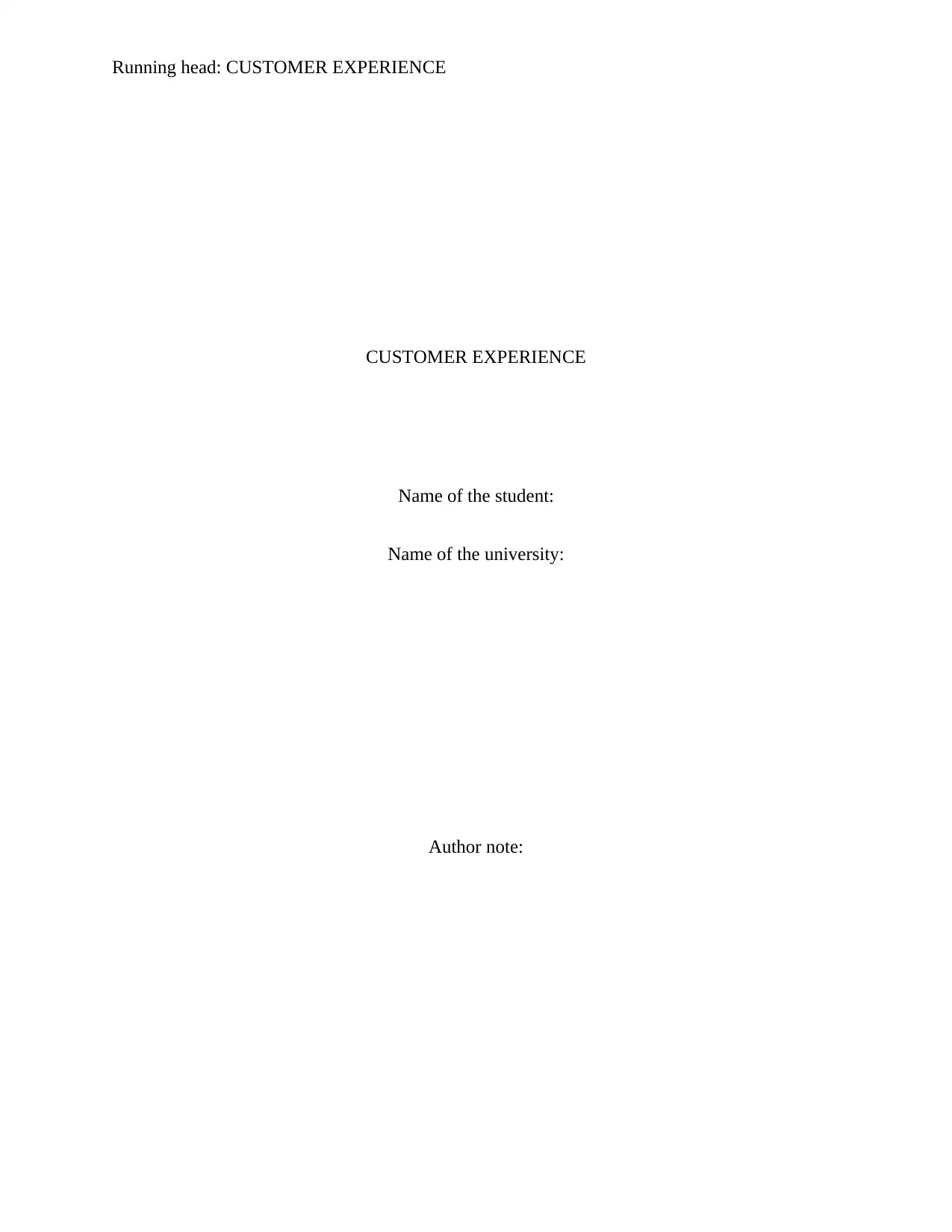
Running head: CUSTOMER EXPERIENCE
CUSTOMER EXPERIENCE
Name of the student:
Name of the university:
Author note:
CUSTOMER EXPERIENCE
Name of the student:
Name of the university:
Author note:
Paraphrase This Document
Need a fresh take? Get an instant paraphrase of this document with our AI Paraphraser
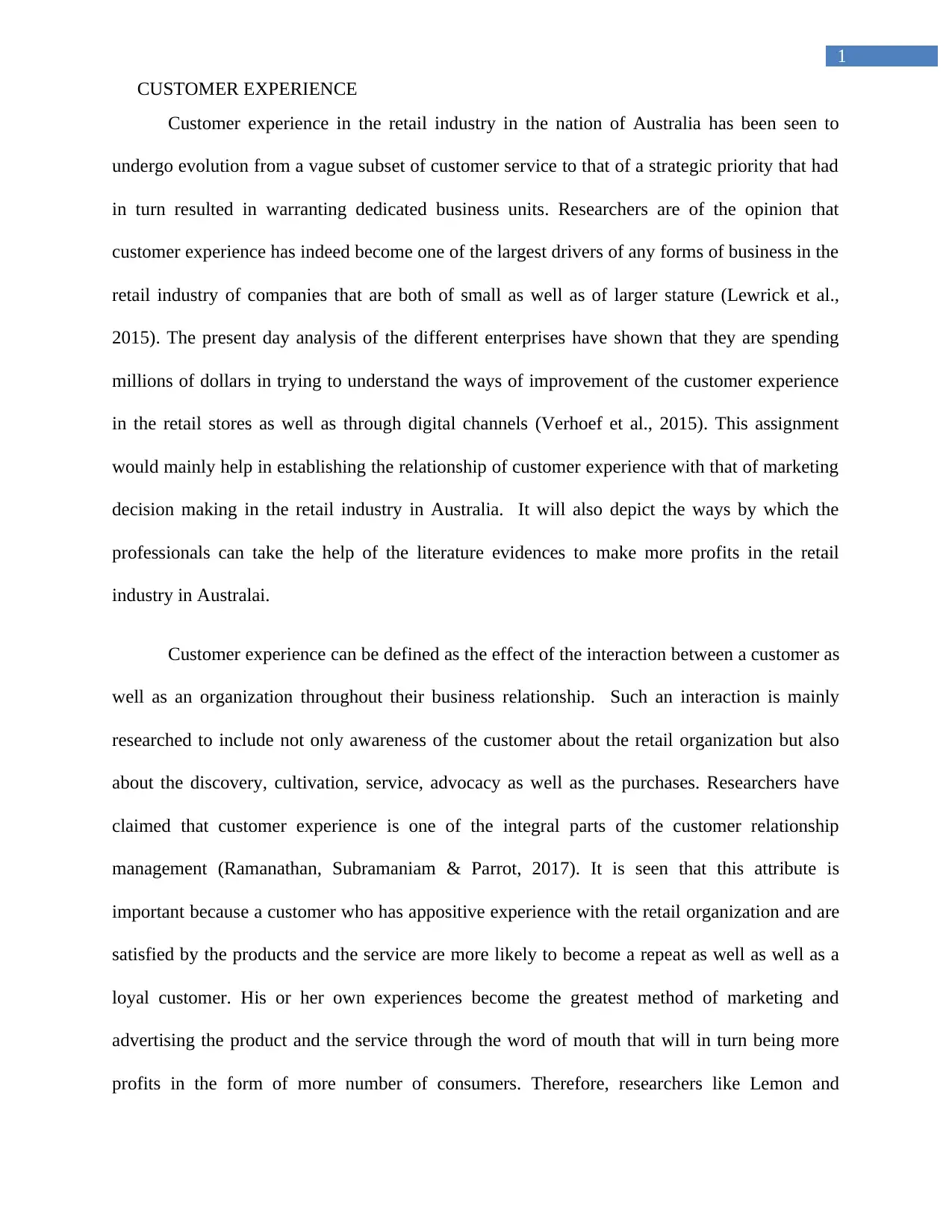
1
CUSTOMER EXPERIENCE
Customer experience in the retail industry in the nation of Australia has been seen to
undergo evolution from a vague subset of customer service to that of a strategic priority that had
in turn resulted in warranting dedicated business units. Researchers are of the opinion that
customer experience has indeed become one of the largest drivers of any forms of business in the
retail industry of companies that are both of small as well as of larger stature (Lewrick et al.,
2015). The present day analysis of the different enterprises have shown that they are spending
millions of dollars in trying to understand the ways of improvement of the customer experience
in the retail stores as well as through digital channels (Verhoef et al., 2015). This assignment
would mainly help in establishing the relationship of customer experience with that of marketing
decision making in the retail industry in Australia. It will also depict the ways by which the
professionals can take the help of the literature evidences to make more profits in the retail
industry in Australai.
Customer experience can be defined as the effect of the interaction between a customer as
well as an organization throughout their business relationship. Such an interaction is mainly
researched to include not only awareness of the customer about the retail organization but also
about the discovery, cultivation, service, advocacy as well as the purchases. Researchers have
claimed that customer experience is one of the integral parts of the customer relationship
management (Ramanathan, Subramaniam & Parrot, 2017). It is seen that this attribute is
important because a customer who has appositive experience with the retail organization and are
satisfied by the products and the service are more likely to become a repeat as well as well as a
loyal customer. His or her own experiences become the greatest method of marketing and
advertising the product and the service through the word of mouth that will in turn being more
profits in the form of more number of consumers. Therefore, researchers like Lemon and
CUSTOMER EXPERIENCE
Customer experience in the retail industry in the nation of Australia has been seen to
undergo evolution from a vague subset of customer service to that of a strategic priority that had
in turn resulted in warranting dedicated business units. Researchers are of the opinion that
customer experience has indeed become one of the largest drivers of any forms of business in the
retail industry of companies that are both of small as well as of larger stature (Lewrick et al.,
2015). The present day analysis of the different enterprises have shown that they are spending
millions of dollars in trying to understand the ways of improvement of the customer experience
in the retail stores as well as through digital channels (Verhoef et al., 2015). This assignment
would mainly help in establishing the relationship of customer experience with that of marketing
decision making in the retail industry in Australia. It will also depict the ways by which the
professionals can take the help of the literature evidences to make more profits in the retail
industry in Australai.
Customer experience can be defined as the effect of the interaction between a customer as
well as an organization throughout their business relationship. Such an interaction is mainly
researched to include not only awareness of the customer about the retail organization but also
about the discovery, cultivation, service, advocacy as well as the purchases. Researchers have
claimed that customer experience is one of the integral parts of the customer relationship
management (Ramanathan, Subramaniam & Parrot, 2017). It is seen that this attribute is
important because a customer who has appositive experience with the retail organization and are
satisfied by the products and the service are more likely to become a repeat as well as well as a
loyal customer. His or her own experiences become the greatest method of marketing and
advertising the product and the service through the word of mouth that will in turn being more
profits in the form of more number of consumers. Therefore, researchers like Lemon and
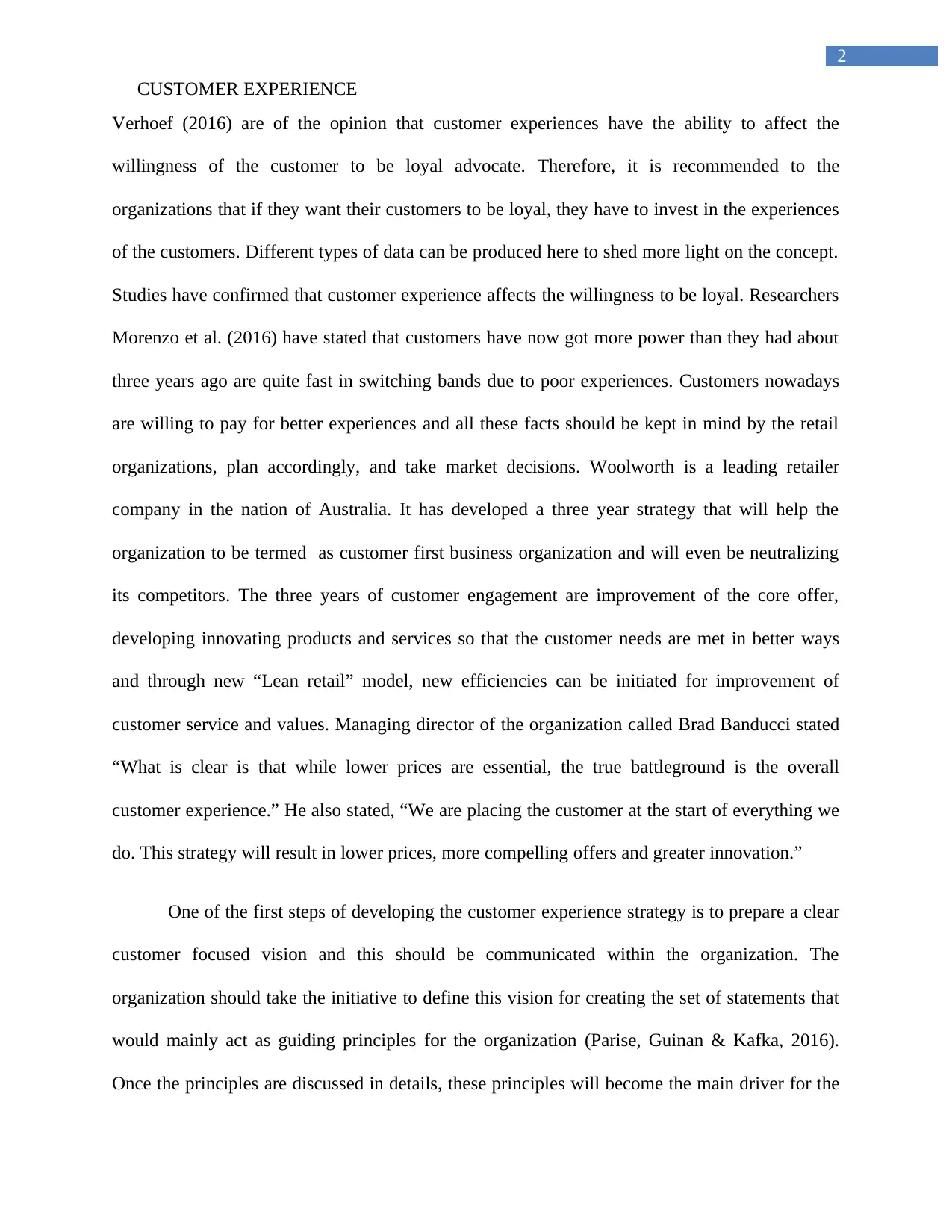
2
CUSTOMER EXPERIENCE
Verhoef (2016) are of the opinion that customer experiences have the ability to affect the
willingness of the customer to be loyal advocate. Therefore, it is recommended to the
organizations that if they want their customers to be loyal, they have to invest in the experiences
of the customers. Different types of data can be produced here to shed more light on the concept.
Studies have confirmed that customer experience affects the willingness to be loyal. Researchers
Morenzo et al. (2016) have stated that customers have now got more power than they had about
three years ago are quite fast in switching bands due to poor experiences. Customers nowadays
are willing to pay for better experiences and all these facts should be kept in mind by the retail
organizations, plan accordingly, and take market decisions. Woolworth is a leading retailer
company in the nation of Australia. It has developed a three year strategy that will help the
organization to be termed as customer first business organization and will even be neutralizing
its competitors. The three years of customer engagement are improvement of the core offer,
developing innovating products and services so that the customer needs are met in better ways
and through new “Lean retail” model, new efficiencies can be initiated for improvement of
customer service and values. Managing director of the organization called Brad Banducci stated
“What is clear is that while lower prices are essential, the true battleground is the overall
customer experience.” He also stated, “We are placing the customer at the start of everything we
do. This strategy will result in lower prices, more compelling offers and greater innovation.”
One of the first steps of developing the customer experience strategy is to prepare a clear
customer focused vision and this should be communicated within the organization. The
organization should take the initiative to define this vision for creating the set of statements that
would mainly act as guiding principles for the organization (Parise, Guinan & Kafka, 2016).
Once the principles are discussed in details, these principles will become the main driver for the
CUSTOMER EXPERIENCE
Verhoef (2016) are of the opinion that customer experiences have the ability to affect the
willingness of the customer to be loyal advocate. Therefore, it is recommended to the
organizations that if they want their customers to be loyal, they have to invest in the experiences
of the customers. Different types of data can be produced here to shed more light on the concept.
Studies have confirmed that customer experience affects the willingness to be loyal. Researchers
Morenzo et al. (2016) have stated that customers have now got more power than they had about
three years ago are quite fast in switching bands due to poor experiences. Customers nowadays
are willing to pay for better experiences and all these facts should be kept in mind by the retail
organizations, plan accordingly, and take market decisions. Woolworth is a leading retailer
company in the nation of Australia. It has developed a three year strategy that will help the
organization to be termed as customer first business organization and will even be neutralizing
its competitors. The three years of customer engagement are improvement of the core offer,
developing innovating products and services so that the customer needs are met in better ways
and through new “Lean retail” model, new efficiencies can be initiated for improvement of
customer service and values. Managing director of the organization called Brad Banducci stated
“What is clear is that while lower prices are essential, the true battleground is the overall
customer experience.” He also stated, “We are placing the customer at the start of everything we
do. This strategy will result in lower prices, more compelling offers and greater innovation.”
One of the first steps of developing the customer experience strategy is to prepare a clear
customer focused vision and this should be communicated within the organization. The
organization should take the initiative to define this vision for creating the set of statements that
would mainly act as guiding principles for the organization (Parise, Guinan & Kafka, 2016).
Once the principles are discussed in details, these principles will become the main driver for the
⊘ This is a preview!⊘
Do you want full access?
Subscribe today to unlock all pages.

Trusted by 1+ million students worldwide
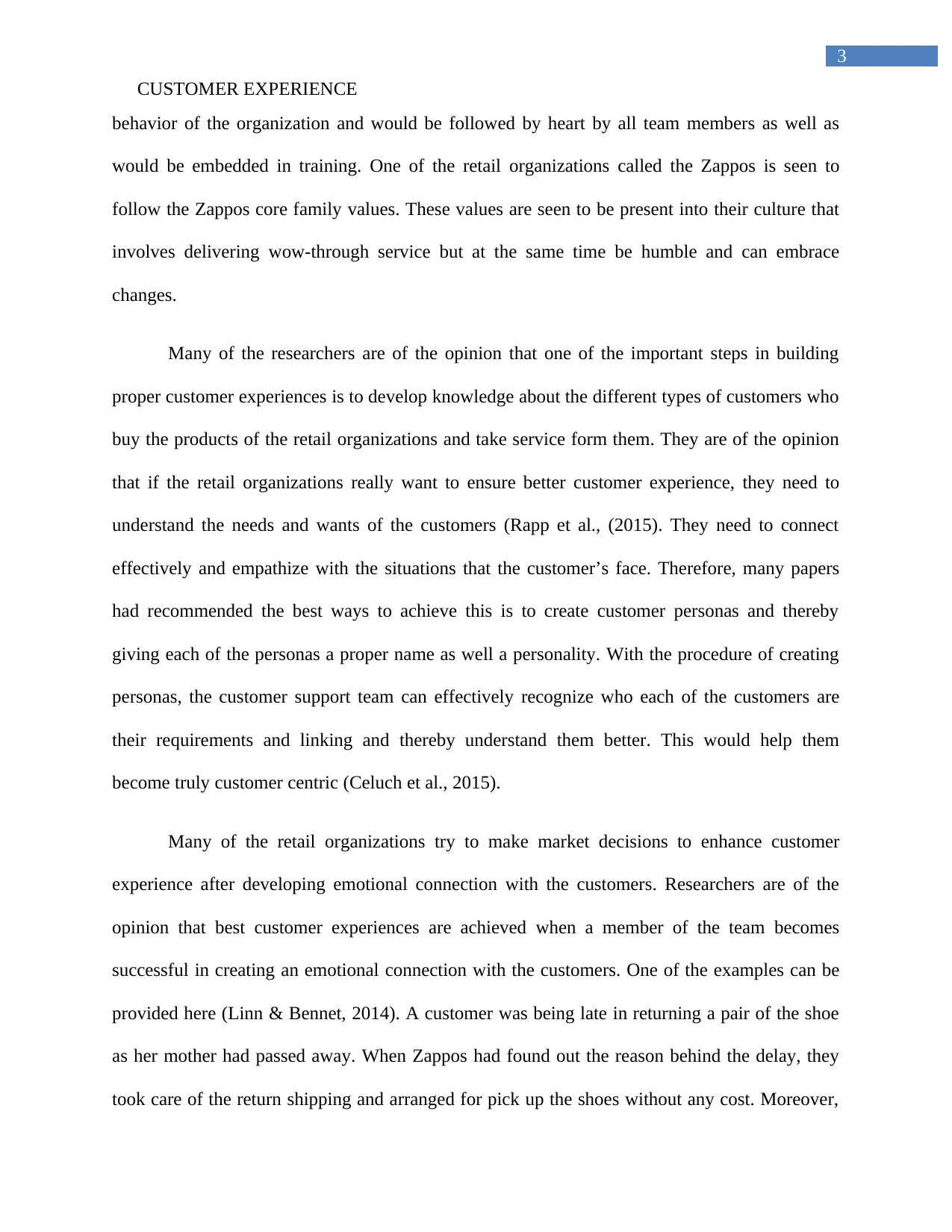
3
CUSTOMER EXPERIENCE
behavior of the organization and would be followed by heart by all team members as well as
would be embedded in training. One of the retail organizations called the Zappos is seen to
follow the Zappos core family values. These values are seen to be present into their culture that
involves delivering wow-through service but at the same time be humble and can embrace
changes.
Many of the researchers are of the opinion that one of the important steps in building
proper customer experiences is to develop knowledge about the different types of customers who
buy the products of the retail organizations and take service form them. They are of the opinion
that if the retail organizations really want to ensure better customer experience, they need to
understand the needs and wants of the customers (Rapp et al., (2015). They need to connect
effectively and empathize with the situations that the customer’s face. Therefore, many papers
had recommended the best ways to achieve this is to create customer personas and thereby
giving each of the personas a proper name as well a personality. With the procedure of creating
personas, the customer support team can effectively recognize who each of the customers are
their requirements and linking and thereby understand them better. This would help them
become truly customer centric (Celuch et al., 2015).
Many of the retail organizations try to make market decisions to enhance customer
experience after developing emotional connection with the customers. Researchers are of the
opinion that best customer experiences are achieved when a member of the team becomes
successful in creating an emotional connection with the customers. One of the examples can be
provided here (Linn & Bennet, 2014). A customer was being late in returning a pair of the shoe
as her mother had passed away. When Zappos had found out the reason behind the delay, they
took care of the return shipping and arranged for pick up the shoes without any cost. Moreover,
CUSTOMER EXPERIENCE
behavior of the organization and would be followed by heart by all team members as well as
would be embedded in training. One of the retail organizations called the Zappos is seen to
follow the Zappos core family values. These values are seen to be present into their culture that
involves delivering wow-through service but at the same time be humble and can embrace
changes.
Many of the researchers are of the opinion that one of the important steps in building
proper customer experiences is to develop knowledge about the different types of customers who
buy the products of the retail organizations and take service form them. They are of the opinion
that if the retail organizations really want to ensure better customer experience, they need to
understand the needs and wants of the customers (Rapp et al., (2015). They need to connect
effectively and empathize with the situations that the customer’s face. Therefore, many papers
had recommended the best ways to achieve this is to create customer personas and thereby
giving each of the personas a proper name as well a personality. With the procedure of creating
personas, the customer support team can effectively recognize who each of the customers are
their requirements and linking and thereby understand them better. This would help them
become truly customer centric (Celuch et al., 2015).
Many of the retail organizations try to make market decisions to enhance customer
experience after developing emotional connection with the customers. Researchers are of the
opinion that best customer experiences are achieved when a member of the team becomes
successful in creating an emotional connection with the customers. One of the examples can be
provided here (Linn & Bennet, 2014). A customer was being late in returning a pair of the shoe
as her mother had passed away. When Zappos had found out the reason behind the delay, they
took care of the return shipping and arranged for pick up the shoes without any cost. Moreover,
Paraphrase This Document
Need a fresh take? Get an instant paraphrase of this document with our AI Paraphraser
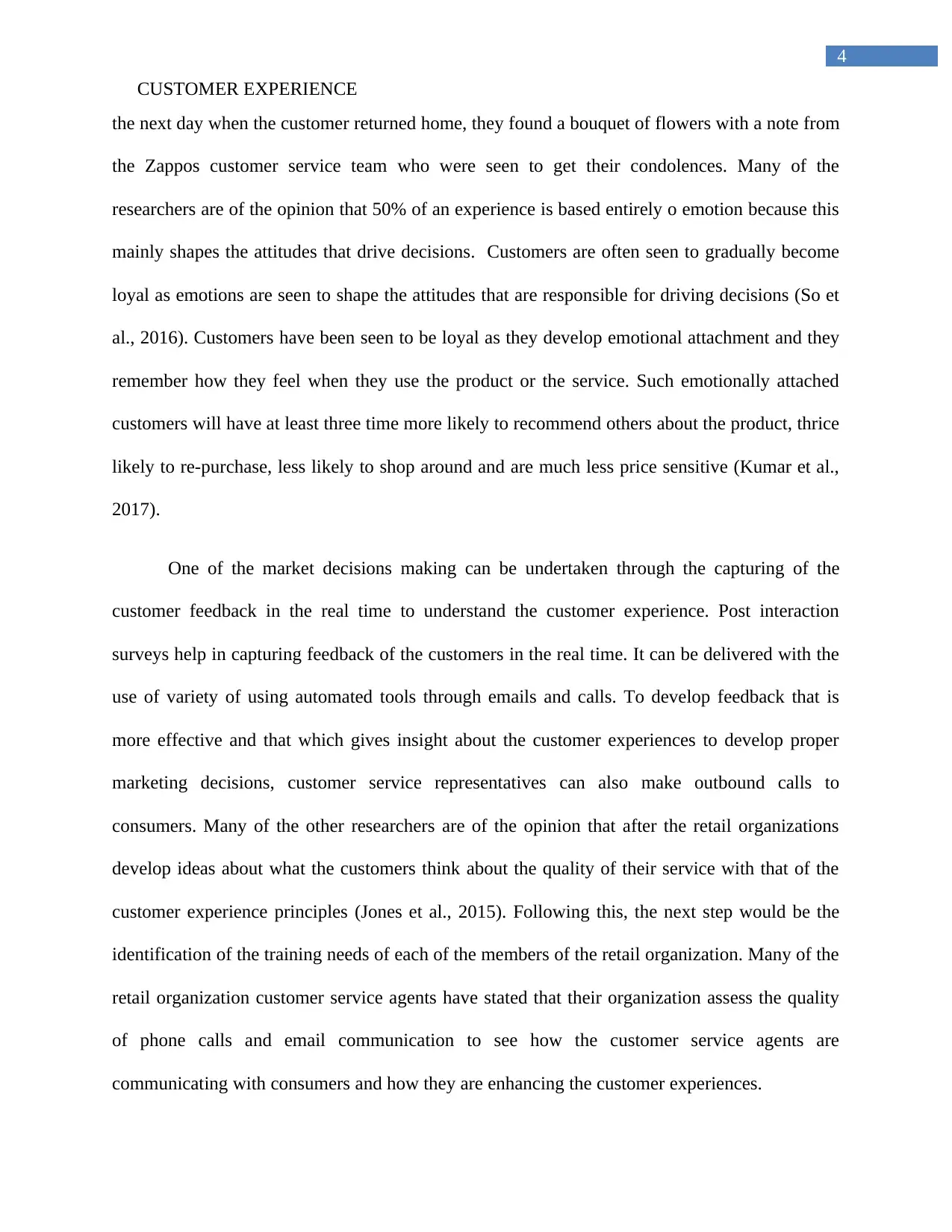
4
CUSTOMER EXPERIENCE
the next day when the customer returned home, they found a bouquet of flowers with a note from
the Zappos customer service team who were seen to get their condolences. Many of the
researchers are of the opinion that 50% of an experience is based entirely o emotion because this
mainly shapes the attitudes that drive decisions. Customers are often seen to gradually become
loyal as emotions are seen to shape the attitudes that are responsible for driving decisions (So et
al., 2016). Customers have been seen to be loyal as they develop emotional attachment and they
remember how they feel when they use the product or the service. Such emotionally attached
customers will have at least three time more likely to recommend others about the product, thrice
likely to re-purchase, less likely to shop around and are much less price sensitive (Kumar et al.,
2017).
One of the market decisions making can be undertaken through the capturing of the
customer feedback in the real time to understand the customer experience. Post interaction
surveys help in capturing feedback of the customers in the real time. It can be delivered with the
use of variety of using automated tools through emails and calls. To develop feedback that is
more effective and that which gives insight about the customer experiences to develop proper
marketing decisions, customer service representatives can also make outbound calls to
consumers. Many of the other researchers are of the opinion that after the retail organizations
develop ideas about what the customers think about the quality of their service with that of the
customer experience principles (Jones et al., 2015). Following this, the next step would be the
identification of the training needs of each of the members of the retail organization. Many of the
retail organization customer service agents have stated that their organization assess the quality
of phone calls and email communication to see how the customer service agents are
communicating with consumers and how they are enhancing the customer experiences.
CUSTOMER EXPERIENCE
the next day when the customer returned home, they found a bouquet of flowers with a note from
the Zappos customer service team who were seen to get their condolences. Many of the
researchers are of the opinion that 50% of an experience is based entirely o emotion because this
mainly shapes the attitudes that drive decisions. Customers are often seen to gradually become
loyal as emotions are seen to shape the attitudes that are responsible for driving decisions (So et
al., 2016). Customers have been seen to be loyal as they develop emotional attachment and they
remember how they feel when they use the product or the service. Such emotionally attached
customers will have at least three time more likely to recommend others about the product, thrice
likely to re-purchase, less likely to shop around and are much less price sensitive (Kumar et al.,
2017).
One of the market decisions making can be undertaken through the capturing of the
customer feedback in the real time to understand the customer experience. Post interaction
surveys help in capturing feedback of the customers in the real time. It can be delivered with the
use of variety of using automated tools through emails and calls. To develop feedback that is
more effective and that which gives insight about the customer experiences to develop proper
marketing decisions, customer service representatives can also make outbound calls to
consumers. Many of the other researchers are of the opinion that after the retail organizations
develop ideas about what the customers think about the quality of their service with that of the
customer experience principles (Jones et al., 2015). Following this, the next step would be the
identification of the training needs of each of the members of the retail organization. Many of the
retail organization customer service agents have stated that their organization assess the quality
of phone calls and email communication to see how the customer service agents are
communicating with consumers and how they are enhancing the customer experiences.
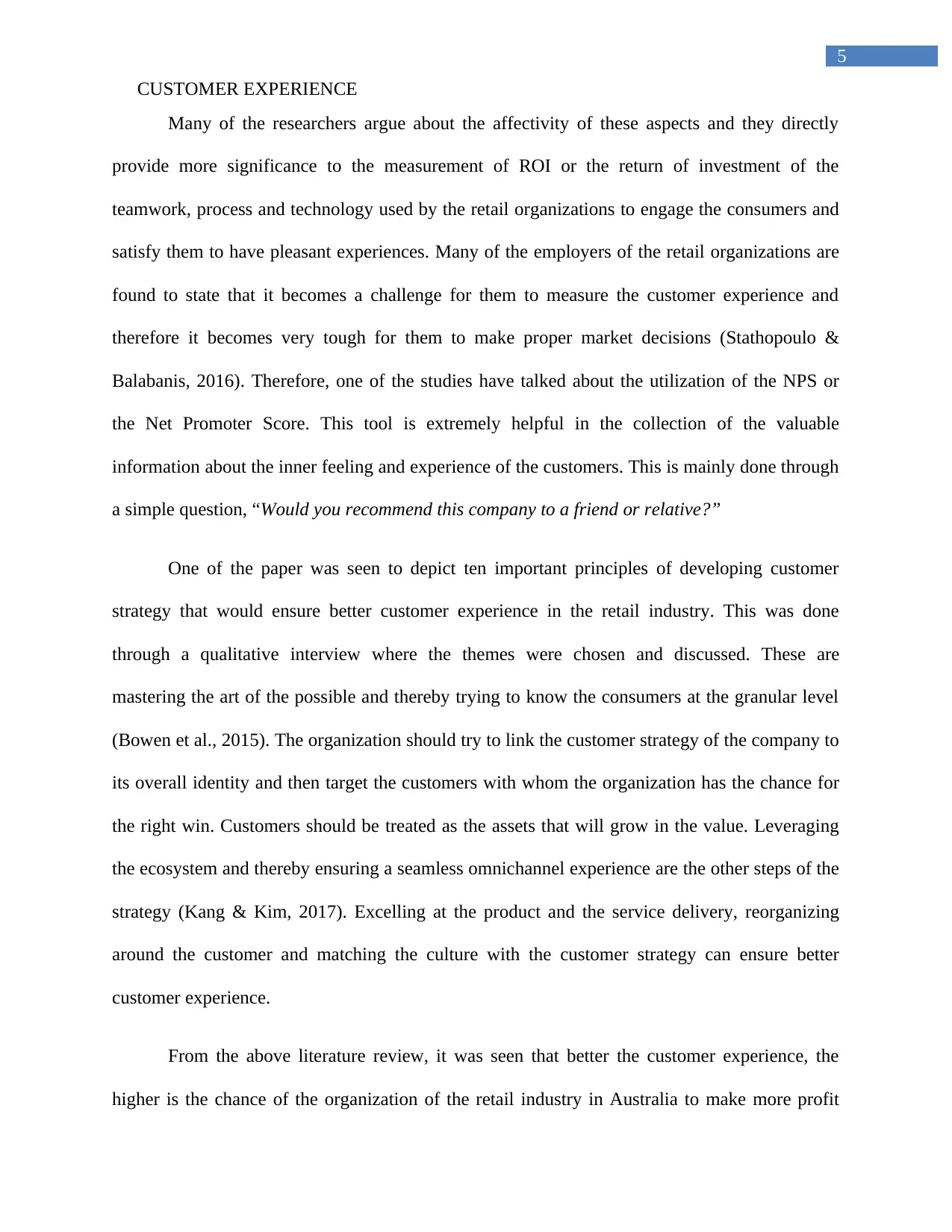
5
CUSTOMER EXPERIENCE
Many of the researchers argue about the affectivity of these aspects and they directly
provide more significance to the measurement of ROI or the return of investment of the
teamwork, process and technology used by the retail organizations to engage the consumers and
satisfy them to have pleasant experiences. Many of the employers of the retail organizations are
found to state that it becomes a challenge for them to measure the customer experience and
therefore it becomes very tough for them to make proper market decisions (Stathopoulo &
Balabanis, 2016). Therefore, one of the studies have talked about the utilization of the NPS or
the Net Promoter Score. This tool is extremely helpful in the collection of the valuable
information about the inner feeling and experience of the customers. This is mainly done through
a simple question, “Would you recommend this company to a friend or relative?”
One of the paper was seen to depict ten important principles of developing customer
strategy that would ensure better customer experience in the retail industry. This was done
through a qualitative interview where the themes were chosen and discussed. These are
mastering the art of the possible and thereby trying to know the consumers at the granular level
(Bowen et al., 2015). The organization should try to link the customer strategy of the company to
its overall identity and then target the customers with whom the organization has the chance for
the right win. Customers should be treated as the assets that will grow in the value. Leveraging
the ecosystem and thereby ensuring a seamless omnichannel experience are the other steps of the
strategy (Kang & Kim, 2017). Excelling at the product and the service delivery, reorganizing
around the customer and matching the culture with the customer strategy can ensure better
customer experience.
From the above literature review, it was seen that better the customer experience, the
higher is the chance of the organization of the retail industry in Australia to make more profit
CUSTOMER EXPERIENCE
Many of the researchers argue about the affectivity of these aspects and they directly
provide more significance to the measurement of ROI or the return of investment of the
teamwork, process and technology used by the retail organizations to engage the consumers and
satisfy them to have pleasant experiences. Many of the employers of the retail organizations are
found to state that it becomes a challenge for them to measure the customer experience and
therefore it becomes very tough for them to make proper market decisions (Stathopoulo &
Balabanis, 2016). Therefore, one of the studies have talked about the utilization of the NPS or
the Net Promoter Score. This tool is extremely helpful in the collection of the valuable
information about the inner feeling and experience of the customers. This is mainly done through
a simple question, “Would you recommend this company to a friend or relative?”
One of the paper was seen to depict ten important principles of developing customer
strategy that would ensure better customer experience in the retail industry. This was done
through a qualitative interview where the themes were chosen and discussed. These are
mastering the art of the possible and thereby trying to know the consumers at the granular level
(Bowen et al., 2015). The organization should try to link the customer strategy of the company to
its overall identity and then target the customers with whom the organization has the chance for
the right win. Customers should be treated as the assets that will grow in the value. Leveraging
the ecosystem and thereby ensuring a seamless omnichannel experience are the other steps of the
strategy (Kang & Kim, 2017). Excelling at the product and the service delivery, reorganizing
around the customer and matching the culture with the customer strategy can ensure better
customer experience.
From the above literature review, it was seen that better the customer experience, the
higher is the chance of the organization of the retail industry in Australia to make more profit
⊘ This is a preview!⊘
Do you want full access?
Subscribe today to unlock all pages.

Trusted by 1+ million students worldwide
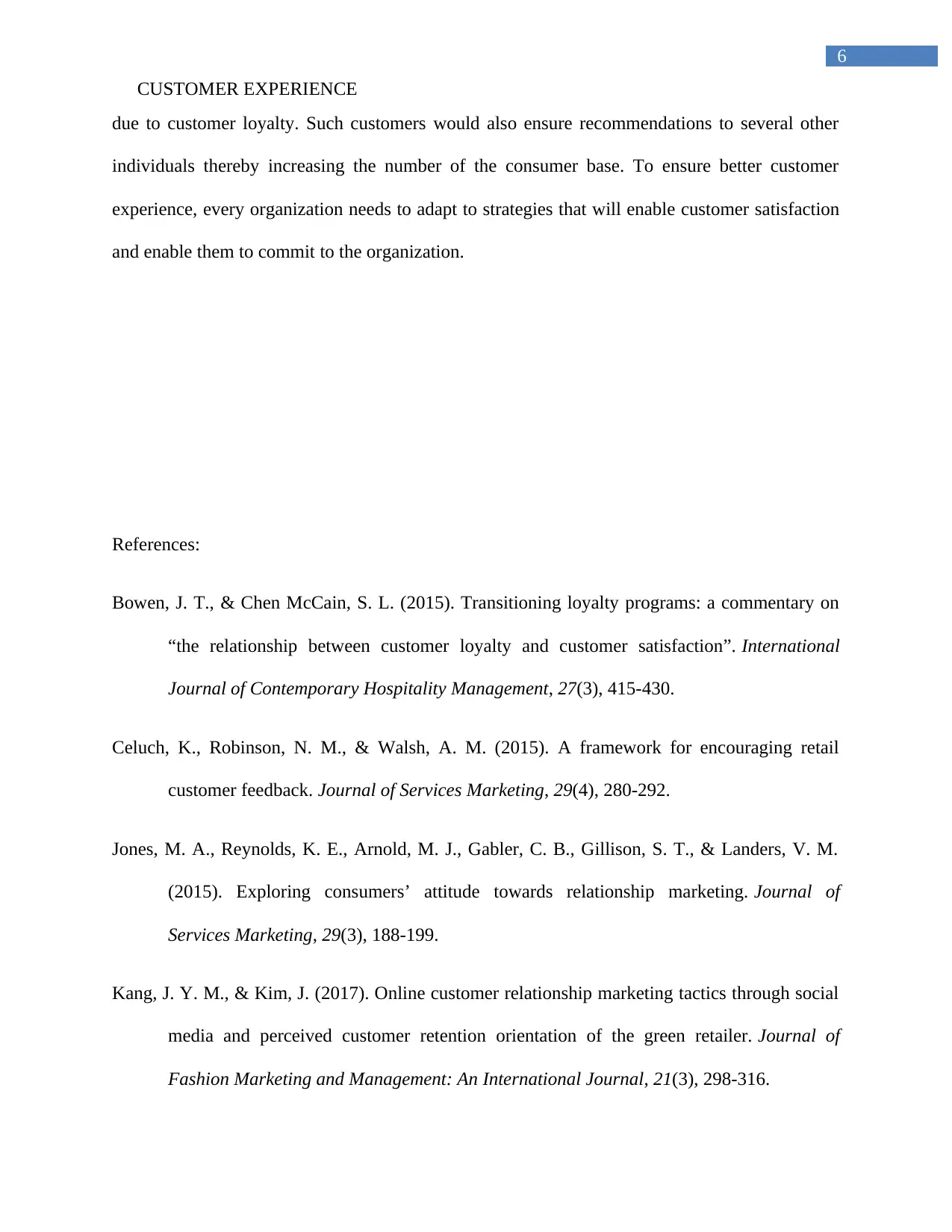
6
CUSTOMER EXPERIENCE
due to customer loyalty. Such customers would also ensure recommendations to several other
individuals thereby increasing the number of the consumer base. To ensure better customer
experience, every organization needs to adapt to strategies that will enable customer satisfaction
and enable them to commit to the organization.
References:
Bowen, J. T., & Chen McCain, S. L. (2015). Transitioning loyalty programs: a commentary on
“the relationship between customer loyalty and customer satisfaction”. International
Journal of Contemporary Hospitality Management, 27(3), 415-430.
Celuch, K., Robinson, N. M., & Walsh, A. M. (2015). A framework for encouraging retail
customer feedback. Journal of Services Marketing, 29(4), 280-292.
Jones, M. A., Reynolds, K. E., Arnold, M. J., Gabler, C. B., Gillison, S. T., & Landers, V. M.
(2015). Exploring consumers’ attitude towards relationship marketing. Journal of
Services Marketing, 29(3), 188-199.
Kang, J. Y. M., & Kim, J. (2017). Online customer relationship marketing tactics through social
media and perceived customer retention orientation of the green retailer. Journal of
Fashion Marketing and Management: An International Journal, 21(3), 298-316.
CUSTOMER EXPERIENCE
due to customer loyalty. Such customers would also ensure recommendations to several other
individuals thereby increasing the number of the consumer base. To ensure better customer
experience, every organization needs to adapt to strategies that will enable customer satisfaction
and enable them to commit to the organization.
References:
Bowen, J. T., & Chen McCain, S. L. (2015). Transitioning loyalty programs: a commentary on
“the relationship between customer loyalty and customer satisfaction”. International
Journal of Contemporary Hospitality Management, 27(3), 415-430.
Celuch, K., Robinson, N. M., & Walsh, A. M. (2015). A framework for encouraging retail
customer feedback. Journal of Services Marketing, 29(4), 280-292.
Jones, M. A., Reynolds, K. E., Arnold, M. J., Gabler, C. B., Gillison, S. T., & Landers, V. M.
(2015). Exploring consumers’ attitude towards relationship marketing. Journal of
Services Marketing, 29(3), 188-199.
Kang, J. Y. M., & Kim, J. (2017). Online customer relationship marketing tactics through social
media and perceived customer retention orientation of the green retailer. Journal of
Fashion Marketing and Management: An International Journal, 21(3), 298-316.
Paraphrase This Document
Need a fresh take? Get an instant paraphrase of this document with our AI Paraphraser
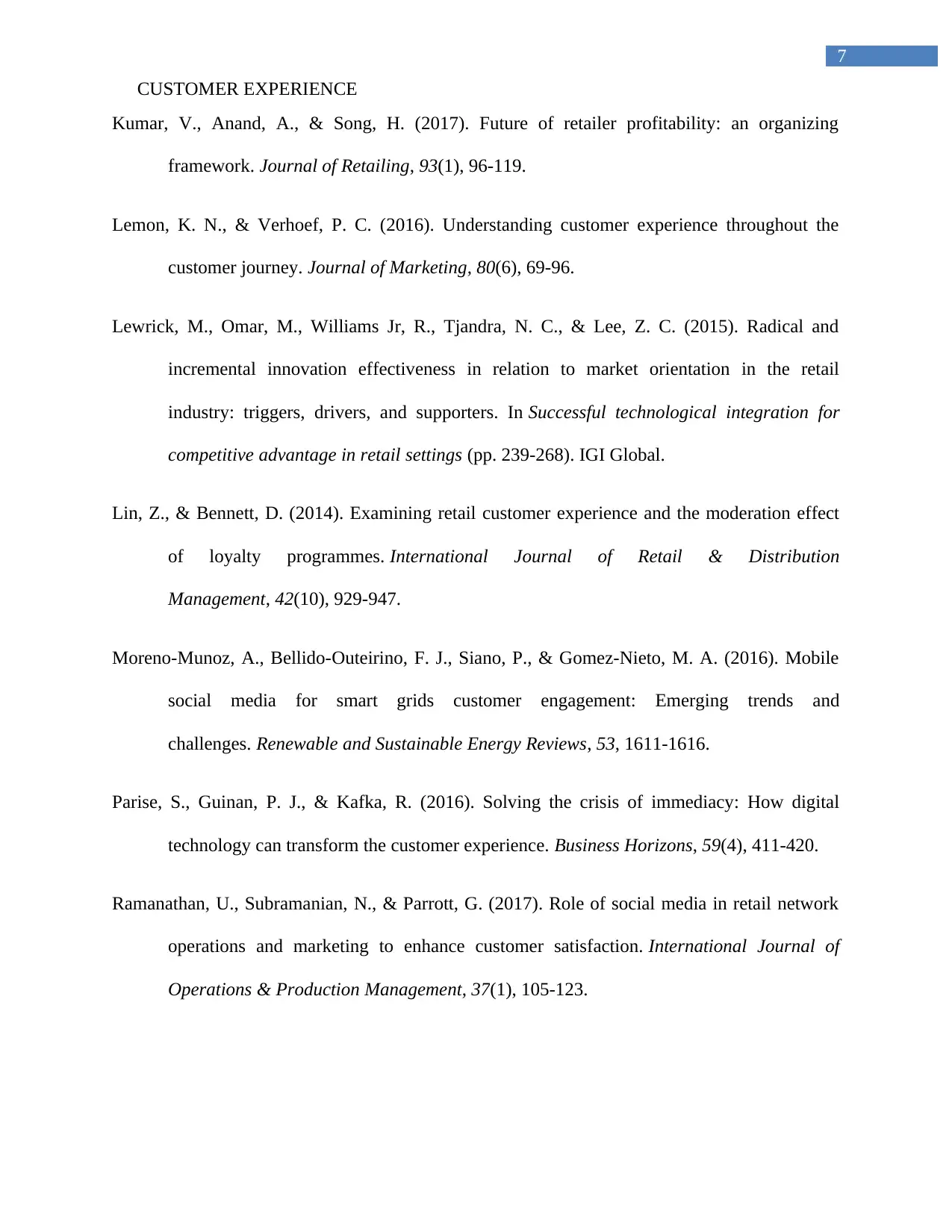
7
CUSTOMER EXPERIENCE
Kumar, V., Anand, A., & Song, H. (2017). Future of retailer profitability: an organizing
framework. Journal of Retailing, 93(1), 96-119.
Lemon, K. N., & Verhoef, P. C. (2016). Understanding customer experience throughout the
customer journey. Journal of Marketing, 80(6), 69-96.
Lewrick, M., Omar, M., Williams Jr, R., Tjandra, N. C., & Lee, Z. C. (2015). Radical and
incremental innovation effectiveness in relation to market orientation in the retail
industry: triggers, drivers, and supporters. In Successful technological integration for
competitive advantage in retail settings (pp. 239-268). IGI Global.
Lin, Z., & Bennett, D. (2014). Examining retail customer experience and the moderation effect
of loyalty programmes. International Journal of Retail & Distribution
Management, 42(10), 929-947.
Moreno-Munoz, A., Bellido-Outeirino, F. J., Siano, P., & Gomez-Nieto, M. A. (2016). Mobile
social media for smart grids customer engagement: Emerging trends and
challenges. Renewable and Sustainable Energy Reviews, 53, 1611-1616.
Parise, S., Guinan, P. J., & Kafka, R. (2016). Solving the crisis of immediacy: How digital
technology can transform the customer experience. Business Horizons, 59(4), 411-420.
Ramanathan, U., Subramanian, N., & Parrott, G. (2017). Role of social media in retail network
operations and marketing to enhance customer satisfaction. International Journal of
Operations & Production Management, 37(1), 105-123.
CUSTOMER EXPERIENCE
Kumar, V., Anand, A., & Song, H. (2017). Future of retailer profitability: an organizing
framework. Journal of Retailing, 93(1), 96-119.
Lemon, K. N., & Verhoef, P. C. (2016). Understanding customer experience throughout the
customer journey. Journal of Marketing, 80(6), 69-96.
Lewrick, M., Omar, M., Williams Jr, R., Tjandra, N. C., & Lee, Z. C. (2015). Radical and
incremental innovation effectiveness in relation to market orientation in the retail
industry: triggers, drivers, and supporters. In Successful technological integration for
competitive advantage in retail settings (pp. 239-268). IGI Global.
Lin, Z., & Bennett, D. (2014). Examining retail customer experience and the moderation effect
of loyalty programmes. International Journal of Retail & Distribution
Management, 42(10), 929-947.
Moreno-Munoz, A., Bellido-Outeirino, F. J., Siano, P., & Gomez-Nieto, M. A. (2016). Mobile
social media for smart grids customer engagement: Emerging trends and
challenges. Renewable and Sustainable Energy Reviews, 53, 1611-1616.
Parise, S., Guinan, P. J., & Kafka, R. (2016). Solving the crisis of immediacy: How digital
technology can transform the customer experience. Business Horizons, 59(4), 411-420.
Ramanathan, U., Subramanian, N., & Parrott, G. (2017). Role of social media in retail network
operations and marketing to enhance customer satisfaction. International Journal of
Operations & Production Management, 37(1), 105-123.
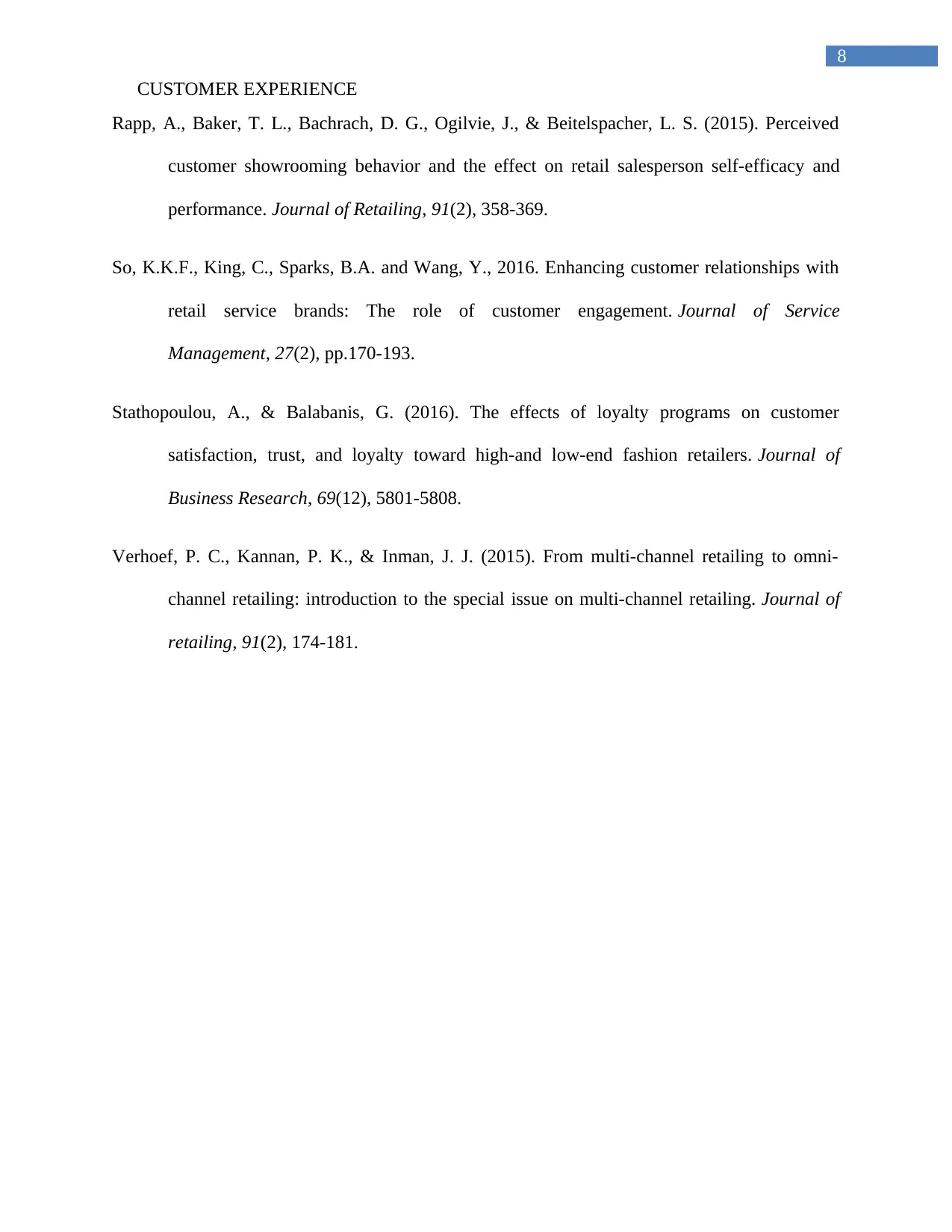
8
CUSTOMER EXPERIENCE
Rapp, A., Baker, T. L., Bachrach, D. G., Ogilvie, J., & Beitelspacher, L. S. (2015). Perceived
customer showrooming behavior and the effect on retail salesperson self-efficacy and
performance. Journal of Retailing, 91(2), 358-369.
So, K.K.F., King, C., Sparks, B.A. and Wang, Y., 2016. Enhancing customer relationships with
retail service brands: The role of customer engagement. Journal of Service
Management, 27(2), pp.170-193.
Stathopoulou, A., & Balabanis, G. (2016). The effects of loyalty programs on customer
satisfaction, trust, and loyalty toward high-and low-end fashion retailers. Journal of
Business Research, 69(12), 5801-5808.
Verhoef, P. C., Kannan, P. K., & Inman, J. J. (2015). From multi-channel retailing to omni-
channel retailing: introduction to the special issue on multi-channel retailing. Journal of
retailing, 91(2), 174-181.
CUSTOMER EXPERIENCE
Rapp, A., Baker, T. L., Bachrach, D. G., Ogilvie, J., & Beitelspacher, L. S. (2015). Perceived
customer showrooming behavior and the effect on retail salesperson self-efficacy and
performance. Journal of Retailing, 91(2), 358-369.
So, K.K.F., King, C., Sparks, B.A. and Wang, Y., 2016. Enhancing customer relationships with
retail service brands: The role of customer engagement. Journal of Service
Management, 27(2), pp.170-193.
Stathopoulou, A., & Balabanis, G. (2016). The effects of loyalty programs on customer
satisfaction, trust, and loyalty toward high-and low-end fashion retailers. Journal of
Business Research, 69(12), 5801-5808.
Verhoef, P. C., Kannan, P. K., & Inman, J. J. (2015). From multi-channel retailing to omni-
channel retailing: introduction to the special issue on multi-channel retailing. Journal of
retailing, 91(2), 174-181.
⊘ This is a preview!⊘
Do you want full access?
Subscribe today to unlock all pages.

Trusted by 1+ million students worldwide
1 out of 9
Related Documents
Your All-in-One AI-Powered Toolkit for Academic Success.
+13062052269
info@desklib.com
Available 24*7 on WhatsApp / Email
![[object Object]](/_next/static/media/star-bottom.7253800d.svg)
Unlock your academic potential
Copyright © 2020–2025 A2Z Services. All Rights Reserved. Developed and managed by ZUCOL.





